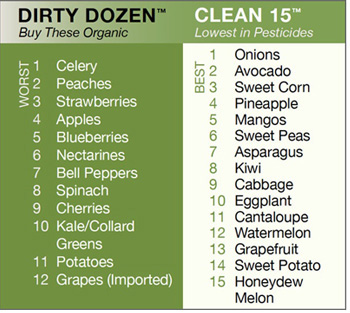Organic vs. Conventional Foods – The reasons why some are spending top dollar on certain grocery items.

What does organic mean anyway?
Under organic production guidelines, conventional non-synthetic pesticides, insecticides and herbicides are generally restricted. Antibiotics and hormones are prohibited from livestock consumption, and genetic modification or application of nanotechnology is generally excluded from organic food. Foods claiming to be organic must be free of artificial food additives, and fewer artificial methods, such as chemical ripening or food irradiation.
Benefits to purchasing organic
- Lack of pesticides in food and environment, which have potential to harm soil, water and wildlife
- Help sustain ecosystems
- Organic farms use less energy and produce less waste, thus less impact on our environment
- Some research has showed when compared to conventional products, organic food production resulted in higher levels of vitamins/antioxidants, and omega 3 fatty acids; lower levels of heavy metals, pesticides, and lower risk of food borne illness such as Salmonella.
Negatives of organics:
- Limited use of food preservatives, which may cause short shelf life or quicker food spoilage; however the longer the food takes to get to your table, the lower the nutritive content. Thus, shorter shelf life gives us reason to consume products faster, and we will get more vitamin and mineral value.
- Organics typically cost 10-40% more than conventional products; USDA quoted switching entirely to organics would raise grocery costs by about $45 per month.
Should you make the switch?
Many have researched the high levels of pesticides in certain foods, frequently termed “The Dirty Dozen”, thus making the switch to organic for these foods in particular is recommended. Research has shown that a high level of pesticides may be toxic to children and those with compromised immune systems (pregnant women, consumers with chronic diseases or those on immunosuppressive medications such as methotrexate, cyclosporine, tacrolomis, or infliximab to name a few). To date, there is not enough research to prove the safety of large doses of pesticides, insecticides and the like, to endorse frequent consumption.
Pesticide Quantity Broken Down*:
Celery – 64 pesticides
Peaches – 62 pesticides
Strawberries – 59 pesticides
Blueberries – 52 pesticides
Leafy Greens – 51 pesticides
Bell peppers – 49 pesticides
Spinach – 48 pesticides
Apples & Cherries – 42 pesticides
Potatoes – 37 pesticides
Grapes – 34 pesticides
Nectarines – 33 pesticides
Pears – 28 pesticides
Carrots – 26 pesticides
Milk – 12 pesticides
Beef fat – 10 pesticides
Pork Fat – 8 pesticides
*Reference: www.thedailygreen.com/healthy-eating/eat-safe/Dirty-Dozen-Foods
The Dirty Dozen Uncovered
Since 1995, the Environmental Working Group has published a list of the most pesticide-contaminated foods based on testing conducted by both the USDA and FDA. This list only reflects measurable pesticide levels after high-powered washing and peeling. This list does not account for foods that are high in antibiotics or hormones. When debating if organic seems appropriate, it is important to think of the part of the fruit or vegetable you will be consuming. As example, celery has no protective skin, thus there is no barrier for the pesticides to remain and discard. Thus, by eating a recommended 5 servings of fresh fruits and vegetables per day, you may be consuming hundreds of pesticides. Long-term effects of this consumption are unknown, thus it is recommended to be cautious.
The nutritional content of the dirty dozen is unparalleled, thus it is important not just to abandon those foods altogether. Many a rich source of fiber, Vitamin A, Vitamin C, Folate, and Vitamin K, the risks of avoiding these foods are more dangerous than the potential risk of pesticide overconsumption. What if I peel the outer layer and eat the flesh; does that help? Well, peeling fruit and/or vegetables will remove the most important nutritive layer of the food; the skin of fruits and vegetables is abundant in fiber, and important potentially cancer preventing phytochemicals such as carotenoids and flavonoids.
Safer Foods to Consume:
Avocados
Bananas
Cabbage
Cantaloupe
Eggplant
Green peas
Kiwi
Mango
Onions
Oranges
Pineapple
Sweet Corn
Tangerines
Watermelon
Next time you grocery shop, remember the dirty dozen. Choose organics of these more often, perhaps even ½ of the time. The cost may only be about $1/day, and the long term benefits of consuming foods without pesticides may be well worth this small price.